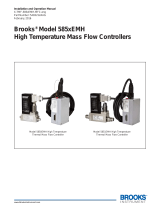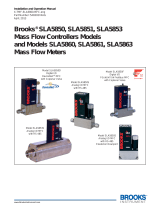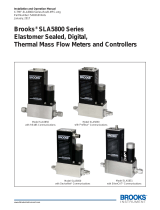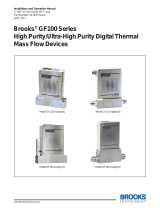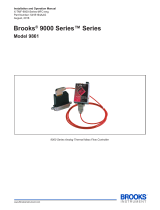Leht laaditakse ...

Installation and Operation Manual
X-TMF-5700-MFM-eng
Part Number: 541B064AAG
July, 2017
Brooks
®
5700 Electronic Flowmeter
Brooks
®
MassRate
TM
5700
Electronic Flowmeter

Installation and Operation Manual
X-TMF-5700-MFM-eng
Part Number: 541B064AAG
July, 2017
Brooks
®
5700 Electronic Flowmeter
ESD (Electrostatic Discharge)
CAUTION: This instrument contains electronic components that are susceptible to damage by static electricity. Proper handling procedures must be observed
during the removal, installation or other handling of internal circuit boards or devices.
Handling Procedure:
1. Power to unit must be removed.
2. Personnel must be grounded, via a wrist strap or other safe, suitable means before any printed circuit card or other internal device is installed,
removed or adjusted.
3. Printed circuit cards must be transported in a conductive container. Boards must not be removed from protective enclosure until immediately before
installation. Removed boards must immediately be placed in protective container for transport, storage or return to factory.
Comments
This instrument is not unique in its content of ESD (electrostatic discharge) sensitive components. Most modern electronic designs contain components
that utilize metal oxide technology (NMOS, SMOS, etc.). Experience has proven that even small amounts of static electricity can damage or destroy these
devices. Damaged components, even though they appear to function properly, exhibit early failure.
Brooks Instrument designs, manufactures and tests its products to meet many national and international standards. These products must be properly
installed, operated and maintained to ensure they continue to operate within their normal specifications. The following instructions must be adhered to
and integrated into your safety program when installing, operating and maintaining Brooks Instrument products.
• To ensure proper performance, use qualified personnel to install, operate, update, program and maintain the product.
• Read all instructions prior to installing, operating and servicing the product. If this instruction manual is not the correct manual, please see back cover
for local sales office contact information. Save this instruction manual for future reference.
WARNING: Do not operate this instrument in excess of the specifications listed in the Instruction and Operation Manual. Failure to heed
this warning can result in serious personal injury and / or damage to the equipment.
• If you do not understand any of the instructions, contact your Brooks Instrument representative for clarification.
• Follow all warnings, cautions and instructions marked on and supplied with the product.
WARNING: Prior to installation ensure this instrument has the required approval ratings to meet local and national codes. Failure to heed this warning can
result in serious personal injury and / or damage to the equipment.
• Install your equipment as specified in the installation instructions of the appropriate instruction manual and per applicable local and national codes.
Connect all products to the proper electrical and pressure sources.
• Operation: (1) Slowly initiate flow into the system. Open process valves slowly to avoid flow surges. (2) Check for leaks around the flow meter inlet
and outlet connections. If no leaks are present, bring the system up to the operating pressure.
• Please make sure that the process line pressure is removed prior to service. When replacement parts are required, ensure that qualified people use
replacement parts specified by Brooks Instrument. Unauthorized parts and procedures can affect the product's performance and place the safe
operation of your process at risk. Look-alike substitutions may result in fire, electrical hazards or improper operation.
• Ensure that all equipment doors are closed and protective covers are in place to prevent electrical shock and personal injury, except when
maintenance is being performed by qualified persons.
WARNING: For liquid flow devices, if the inlet and outlet valves adjacent to the devices are to be closed for any reason, the devices must be completely
drained. Failure to do so may result in thermal expansion of the liquid that can rupture the device and may cause personal injury.
All pressure equipment with an internal pressure greater than 0.5 bar (g) and a size larger than 25mm or 1" (inch) falls under the Pressure Equipment Directive (PED).
• The Specifications Section of this manual contains instructions related to the PED directive.
• Products described in this manual are in compliance with EN directive 2014/34/EU.
• All Brooks Instrument Flowmeters fall under fluid group 1.
• Products larger than 25mm or 1" (inch) are in compliance with PED category I, II or III.
• Products of 25mm or 1" (inch) or smaller are Sound Engineering Practice (SEP).
The Brooks Instrument (electric/electronic) equipment bearing the CE mark has been successfully tested to the regulations of the Electro Magnetic
Compatibility (EMC directive 2014/30/EU).
Special attention however is required when selecting the signal cable to be used with CE marked equipment.
Quality of the signal cable, cable glands and connectors:
Brooks Instrument supplies high quality cable(s) which meets the specifications for CE certification.
If you provide your own signal cable you should use a cable which is overall completely screened with a 100% shield.
“D” or “Circular” type connectors used should be shielded with a metal shield. If applicable, metal cable glands must be used providing cable screen clamping.
The cable screen should be connected to the metal shell or gland and shielded at both ends over 360 Degrees.
The shield should be terminated to an earth ground.
Card Edge Connectors are standard non-metallic. The cables used must be screened with 100% shield to comply with CE certification.
The shield should be terminated to an earth ground.
For pin configuration : Please refer to the enclosed Instruction Manual.
European Pressure Equipment Directive (PED)
European Electromagnetic Compatibility (EMC)
Essential Instructions
Read before proceeding!

Installation and Operation Manual
X-TMF-5700-MFM-eng
Part Number: 541B064AAG
July, 2017
Brooks
®
5700 Electronic Flowmeter
Dear Customer,
We appreciate this opportunity to service your flow measurement and control requirements with a Brooks
Instrument device. Every day, flow customers all over the world turn to Brooks Instrument for solutions to their
gas and liquid low-flow applications. Brooks provides an array of flow measurement and control products for
various industries from biopharmaceuticals, oil and gas, fuel cell research and chemicals, to medical devices,
analytical instrumentation, semiconductor manufacturing, and more.
The Brooks product you have just received is of the highest quality available, offering superior performance,
reliability and value to the user. It is designed with the ever changing process conditions, accuracy requirements
and hostile process environments in mind to provide you with a lifetime of dependable service.
We recommend that you read this manual in its entirety. Should you require any additional information concerning
Brooks products and services, please contact your local Brooks Sales and Service Office listed on the back cover
of this manual or visit www.BrooksInstrument.com
Yours sincerely,
Brooks Instrument

Installation and Operation Manual
X-TMF-5700-MFM-eng
Part Number: 541B064AAG
July, 2017
Brooks
®
5700 Electronic Flowmeter
THIS PAGE WAS
INTENTIONALLY
LEFT BLANK

i
Installation and Operation Manual
X-TMF-5700-MFM-eng
Part Number: 541B064AAG
July, 2017 Brooks
®
5700 Electronic Flowmeter
Contents
Paragraph Page
Number Number
Section 1 Introduction
1-1 Purpose ............................................................................................................................................ 1-1
1-2 Specifications ................................................................................................................................... 1-2
Section 2 Installation
2-1 General.............................................................................................................................................2-1
2-2 Receipt of Equipment ....................................................................................................................... 2-1
2-3 Recommended Storage Practice......................................................................................................2-1
2-4 Return Shipment .............................................................................................................................. 2-1
2-5 Transit Precautions .......................................................................................................................... 2-2
2-6 Removal from Storage......................................................................................................................2-2
2-7 Installation Tips................................................................................................................................. 2-2
2-8 In-Line Filter ..................................................................................................................................... 2-4
2-9 Positive Shut-Off Valve.....................................................................................................................2-4
2-10 Gas Connections.............................................................................................................................. 2-4
2-11 Electrical Interfacing.........................................................................................................................2-5
2-12 Zero Adjustment ...............................................................................................................................2-5
Section 3 Operation
3-1 Basic Operation................................................................................................................................ 3-1
3-2 Output Signal....................................................................................................................................3-1
3-3 Process Flow Rate ........................................................................................................................... 3-1
3-4 Use of Conversion Tables ................................................................................................................3-2
Section 4 Maintenance
4-1 General.............................................................................................................................................4-1
4-2 Troubleshooting................................................................................................................................ 4-1
Section 5 Parts List
5-1 General.............................................................................................................................................5-1
SectionA Essential Instructions.............................................................................................................. A1
Warranty, Local Sales/Service Contact Information....................................................................... Back Cover
Figures
Figure Page
Number Number
2-1 Model MassRate 5700 Dimensions/Electrical Connector.................................................................2-3
5-1 Parts drawing ................................................................................................................................... 5-1
Tables
Table Page
Number Number
1-1 Specifications ................................................................................................................................... 2-4
2-1 Recommended Filter Size ................................................................................................................2-4
3-1 Output vs. Flow rate .........................................................................................................................3-1
3-2 Nitrogen Based Conversion Factors................................................................................................. 3-3
4-1 Bench Troubleshooting.....................................................................................................................4-3
4-2 Sensor Troubleshooting ...................................................................................................................4-3
5-1 Model MassRate 5700 Replacement Parts List ...............................................................................5-1

ii
Installation and Operation Manual
X-TMF-5700-MFM-eng
Part Number: 541B064AAG
July, 2017
Brooks
®
5700 Electronic Flowmeter
Contents
THIS PAGE WAS
INTENTIONALLY
LEFT BLANK

1-1
Installation and Operation Manual
X-TMF-5700-MFM-eng
Part Number: 541B064AAG
July, 2017
Brooks
®
5700 Electronic Flowmeter
Section 1 Introduction
1-1 Purpose
The Brooks
®
MassRate
TM
5700 Electronic Flowmeter is a mass flow
measurement device designed for repeatably measuring flows of gases.
The MassRate 5700 produces a stable gas flow indication which eliminates
the need to continuously monitor and compensate for changing gas
pressures and temperatures. This instruction manual is intended to provide
the user with all the information necessary to install, operate and maintain
the Brooks MassRate 5700 Flowmeter. This manual is organized into the
following sections:
Section 1 - Introduction
Section 2 - Installation
Section 3 - Operation
Section 4 - Maintenance
Section 5 - Parts List
Section A - Essential Instructions
It is recommended that this manual be read in its entirety before attempting
to operate the MassRate 5700.
1-2 Specifications (See Table 1-1)

1-2
Installation and Operation Manual
X-TMF-5700-MFM-eng
Part Number: 541B064AAG
July, 2017Brooks
®
5700 Electronic Flowmeter
Section 1 Introduction
SpecificationsSpecifications
SpecificationsSpecifications
Specifications
57005700
57005700
5700
Standard Flow Ranges*Standard Flow Ranges*
Standard Flow Ranges*Standard Flow Ranges*
Standard Flow Ranges* 0-10, 0-20, 0-50, 0-100, 0-200, 0-500 ml/min
0-1, 0-2, 0-5, 0-10, 0-20, 0-50 liters/min
RangeabilityRangeability
RangeabilityRangeability
Rangeability 20:1
RepeatabilityRepeatability
RepeatabilityRepeatability
Repeatability 0.5% full scale
AccuracyAccuracy
AccuracyAccuracy
Accuracy 5% full scale including linearity
Temperature SensitivityTemperature Sensitivity
Temperature SensitivityTemperature Sensitivity
Temperature Sensitivity Zero: less than ±0.075% full scale per degree C
Span: less than ±0.075% full scale per degree C
Pressure SensitivityPressure Sensitivity
Pressure SensitivityPressure Sensitivity
Pressure Sensitivity Less than 0.05% per psi (0.0073% per KPa)
Mounting Attitude SensitivityMounting Attitude Sensitivity
Mounting Attitude SensitivityMounting Attitude Sensitivity
Mounting Attitude Sensitivity Less than 0.5% full scale shift after rezeroing
Working PressureWorking Pressure
Working PressureWorking Pressure
Working Pressure Up to 150 psig (1034 KPa)
Temperature LimitsTemperature Limits
Temperature LimitsTemperature Limits
Temperature Limits Operating: 5 to 65°C
Non-operating: -25 to 100°C
Materials of ConstructionMaterials of Construction
Materials of ConstructionMaterials of Construction
Materials of Construction 304 and 316 Stainless Steel
ConnectionsConnections
ConnectionsConnections
Connections Mechanical: 1/4” FNPT
Electrical: 5-Pin post header horizontal mount AMP 171826-5. The mating connector is AMP 172053-5
PowerPower
PowerPower
Power 11.5 to 15.5 Vdc, 50 mA
Output SignalOutput Signal
Output SignalOutput Signal
Output Signal 0-5 Vdc into 1000 ohms or greater
DimensionsDimensions
DimensionsDimensions
Dimensions See Dimensions figure
WeightWeight
WeightWeight
Weight 1lb/0.5Kg
*Nitrogen, 760 torr Reference Pressure, Reference Temperature defined by User
Table 1-1 Specifications

2-1
Installation and Operation Manual
X-TMF-5700-MFM-eng
Part Number: 541B064AAG
July, 2017
Brooks
®
5700 Electronic Flowmeter
Section 2 Installation
2-1 General
This section provides installation instructions for the Brooks Model 5700
electronic flowmeter.
2-2 Receipt of Equipment
When the equipment is received, the outside packing case should be
checked for damage incurred during shipment. If the packing case is
damaged, the local carrier should be notified at once regarding his liability.
A report should be submitted to the nearest Brooks Instrument location
listed on the Global Service Network page on our website:
BrooksInstrument.com/GlobalSupportCenters
Remove the envelope containing the packing list. Outside of your clean area,
carefully remove the equipment from the packing case. Make sure spare
parts are not discarded with the packing material. Inspect for damaged or
missing parts.
2-3 Recommended Storage Practice
If intermediate or long-term storage of equipment is required, it is
recommended that the equipment be stored in accordance with the
following:
a. In the original vacuum bag and shipping container.
b. In a sheltered area with the following conditions:
1. Ambient temperature 21°C (70°F) nominal, 32°C (90°F) maximum
and 7°C (45°F) minimum.
2. Relative humidity 45% nominal, 60% maximum and 25% minimum.
2-4 Return Shipment
Prior to returning any instrument to the factory for any reason, visit our
website for instructions on how to obtain a Return Materials Authorization
Number (RMA #) and complete a Decontamination Statement to
accompany it: BrooksInstrument.com/Service. All instruments returned to
Brooks also require a Material Safety Data Sheet (MSDS) for the fluid(s)
used in the instrument. Failure to provide this information will delay
processing of the instrument.
Instrument must have been purged in accordance with the following:

2-2
Installation and Operation Manual
X-TMF-5700-MFM-eng
Part Number: 541B064AAG
July, 2017
Brooks
®
5700 Electronic Flowmeter
Section 2 Installation
2-5 Transit Precautions
To safeguard against damage during transit, transport the instrument to the
installation site in the same container used for transportation from the
factory if circumstances permit.
2-6 Removal from Storage
Upon removal from storage, a visual inspection should be conducted to
verify the condition of the equipment is “as received.” If the equipment has
been in storage in conditions in excess of those recommended (See
Section 2-3), the device should be subjected to a pneumatic pressure test
in accordance with applicable vessel codes.
2-7 Installation Tips (Refer to Figure 2-1)
a. The MassRate 5700 should be located in a clean dry atmosphere
relatively free from shock and vibration.
b. Leave sufficient room for access to the electrical components.
c. The MassRate 5700 Flowmeter can be installed in any position.
However, mounting orientations other than the original horizontal factory
calibration couldresult in a ±0.5% maximum full scale shift after
re-zeroing.
d.When installing flowmeters, be aware that sharp abrupt angles in the
system piping directly upstream of the meter may cause a small shift in
accuracy. If possible, have 10 pipe diameters of straight tubing upstream of
the MassRate
5700 Flowmeter.

2-3
Installation and Operation Manual
X-TMF-5700-MFM-eng
Part Number: 541B064AAG
July, 2017
Brooks
®
5700 Electronic Flowmeter
Section 2 Installation
Figure 2-1 Model MassRate Dimensions/Electrical Connector
Pin Electrical Pin Out
No.
5 Supply Common
4 0-5V Flow Signal Out
3 Not Used
2 0-5V Flow Signal Common
1 +12 to +15Vdc Supply
Fitting Size & Type "X" Dim.
1/8 Compression 5.12 ±.125
[130.0]
1/4 Compression 5.20 ±.125
[132.1]
3/8 Compression 5.30 ±.125
[134.6]
Dimensions in inches [mm]

2-4
Installation and Operation Manual
X-TMF-5700-MFM-eng
Part Number: 541B064AAG
July, 2017
Brooks
®
5700 Electronic Flowmeter
Section 2 Installation
2-8 In-Line Filter
It is recommended that an in-line filter be installed upstream from the
flowmeter to prevent the possibility of any foreign material entering the flow
sensor. Refer to Table 2-1 for recommended filter size. The filter should be
periodically replaced or ultrasonically cleaned.
Flow Rate Filter Size
10,20,50,100 sccm 0.5 micron
200,500 sccm 2 micron
1,2,5 slpm 10 micron
10,20,50 slpm 40 micron
Table 2-1 Recommended Filter Size
2-9 Positive Shut-Off Valve
It is recommended that a positive shut-off valve be installed in-line with the
MassRate 5700. The position of this valve, upstream or downstream of the
meter will depend upon the specific application.
2-10 Gas Connections
The MassRate 5700 comes with integrally machined 1/4" female NPT
mechanical connections. Optional 1/8", 1/4", or 3/8" compression fittings
may be supplied with the meter. For flow rates above 10 slpm, 3/8"
compression fittings are recommended. It is recommended that 1/4" wide
pipe tape, not pipe dope, be used to install fittings or adapters into this
meter. The following steps should be followed during mechanical
installation:
a.Clean both male and female tapered thread ends to ensure removal of
dirt or previously applied antiseize compound or tape.
b.Beginning at the first thread, wrap tape in the direction of the male
tapered thread spiral, and join with a slight overlap. (Two wraps are
suggested for stainless steel tapered pipe threads.)
c.Make sure tape does not overhang the first thread, as the tape could
shred and get into the fluid system.
d.Cut off excess tape. Draw the free end of the tapearound the threads
tautly so that it conforms to the threads. Press firmly at the overlay point.
The connection is now ready for proper make-up.
The entire system should be pressurized and leak tested with a dry inert
gas prior to operation.

2-5
Installation and Operation Manual
X-TMF-5700-MFM-eng
Part Number: 541B064AAG
July, 2017
Brooks
®
5700 Electronic Flowmeter
Section 2 Installation
2-11 Electrical Interfacing
To insure proper operation, the MassRate 5700 must be connected per
Figure 2-1. A positive 12 to 15 Vdc power source must be connected to pin
1 and common to pin 5. Under normal operating conditions this meter will
draw less than 50 mA. The flow output is a linear 0-5 Vdc signal on pins 2
and 4.
The electrical connector is a 5 pin post header horizontal mount AMP
171826-5. The recommended mating connector is AMP 172053-5.
NOTE: IF MassRate 5700 is going to be located in a noisy
environment (motors, pumps, etc.), it is recommended that the body
is connected to earth ground. This can be done by attaching a
ground wire to either mounting screw.
2-12 Zero Adjustment
Each MassRate 5700 is factory adjusted to provide a 0 ±10mVdc signal at
zero flow. If readjustment is necessary refer to Figure 2-1 for zero
potentiometer location and follow instructions a through f listed below.
a.Mount the flowmeter in its final configuration.
b.Close the in-line positive shutoff valve. Turn on the gas supply and/or
vacuum system.
c.Apply 12 to 15 Vdc and allow 20 minutes for the instrument to warmup
and stabilize.
d.Using a suitable voltmeter check the flowmeter output signal on pins 2
and 4.
e.If the output is not 0 ±10 mVdc check the system for leaks.
f. If no leaks are found adjust the zero potentiometer until the desired
output is obtained.

2-6
Installation and Operation Manual
X-TMF-5700-MFM-eng
Part Number: 541B064AAG
July, 2017
Brooks
®
5700 Electronic Flowmeter
Section 2 Installation
THIS PAGE WAS
INTENTIONALLY
LEFT BLANK

3-1
Installation and Operation Manual
X-TMF-5700-MFM-eng
Part Number: 541B064AAG
July, 2017
Brooks
®
5700 Electronic Flowmeter
Section 3 Operation
3-1 Basic Operation
a. Close the in-line positive shutoff valve.
b. Turn on the gas supply and/or vacuum system.
c. Apply 12 to 15 Vdc and allow 20 minutes for the instrument to
warmup and stabilize.
d. Adjust zero potentiometer if necessary. Refer to Zero Adjustment
Section 2-8.
e. Open the valve to allow flow to pass through the meter. Monitor the
flow output signal.
3-2 Output Signal
The flow output from the MassRate 5700 is a 0-5 Vdc signal linear with
flow rate. Some output versus flow points are shown in Table 3-1 for
reference.
3-3 Process Flow Rate
Each MassRate 5700 is calibrated on Nitrogen for a specific full scale flow
rate. That flow rate is indicated on the label of the instrument. If a process
gas other than Nitrogen is specified when the instrument is ordered, a
conversion factor based on the specific heat of the process gas is used to
determine a new full scale flow. This process gas and new full scale flow
will also be indicated on the label. If using a process gas other than that
specified at the time of order placement, a new full scale flow can be
determined as detailed in Section 3-4.
Table 3-1 Output vs. Flow Rate
Output Signal Flow Rate
(Vdc) (% Full Scale)
5.0 100
3.75 75
2.5 50
1.25 25
0.5 10

3-2
Installation and Operation Manual
X-TMF-5700-MFM-eng
Part Number: 541B064AAG
July, 2017
Brooks
®
5700 Electronic Flowmeter
Section 3 Operation
3-4 Use of Conversion Factors
A list of sensor conversion factors is given in Table 3-2. To change to a new
gas, multiply the meter output by the sensor factor for the new gas.
Output
full Signal Appropriate
Actual gas = scale x (Vdc) x sensor conversion
flow rate N
2
factor of the new gas
Flow 5.000
Example:
The flowmeter is calibrated for 10 slpm Nitrogen.
The process gas is carbon dioxide.
The flowmeter output is 3.750 volts (75%).
What is the actual carbon dioxide flow?
Actual CO
2
= 10 x 3.75 Vdc x .773
flow rate slpm 5.0 Vdc
= 7.5 slpm x .773 = 5.798 slpm
In order to calculate the conversion factor for a gas mixture the following
formula should be used:
Sensor 100
Conversion = P1 P2 Pn
sensor + sensor + sensor
conversion conversion conversion
factor 1 factor 2 factor n
Where, P1 = percentage (%) of gas 1 (by volume)
P2 = percentage (%) of gas 2 (by volume)
Pn = percentage (%) of gas n (by volume)
Example:
The gas is 20% Helium (He) and 80% Chlorine (CI) by volume.
Sensor conversion factor for the mixture is:
100
Mixture = = .946
Factor 20 + 80
1.386 .876
It is generally accepted that the flow rate derived from this equation is only
accurate to ±5%. The sensor conversion factors given in Table 3-2 are
calculated based on a gas temperature of 21°C and a pressure of one
atmosphere. Gas conditions that vary widely from these reference
conditions may cause an additional error due to the change in specific
heat.

3-3
Installation and Operation Manual
X-TMF-5700-MFM-eng
Part Number: 541B064AAG
July, 2017
Brooks
®
5700 Electronic Flowmeter
Section 3 Operation
GAS NAME FORMULA SENSOR
FACTOR
Hexafuoropropylene (HFP) C
3
F
6
0.249
Hexamethyldisilazane (HMDS) C
6
H
19
NSi
2
0.139
Hexane C
6
H
14
0.204
Hydrogen H
2
1.008
Hydrogen Bromide HBr 0.987
Hydrogen Chloride HCL 0.983
Hydrogen Cyanide HCN 0.744
Hydrogen Fluoride HF 0.998
Hydrogen Iodide HI 0.953
Hydrogen Selenide H
2
Se 0.837
Hydrogen Sulfide H
2
S 0.850
Iodine Pentafluoride IF
5
0.283
Isobutane C
4
H
10
0.260
Isobutene C
4
H
8
0.289
Krypton Kr 1.382
Methane CH
4
0.763
Methylacetylene C
3
H
4
0.473
Methyl Bromide CH
3
Br 0.646
3-Methyl-1-butene C
5
H
10
0.252
Methyl Chloride CH
3
CL 0.687
Methyl Fluoride CH
3
F 0.761
Methyl Mercaptan CH
4
S 0.588
Methyl Vinyl Ether C
3
H
6
O 0.377
Monomethylamine CH
3
NH
2
0.565
Neon Ne 1.398
Nickel Carbonyl Ni(CO)
4
0.212
Nitric Oxide NO 0.995
Nitrogen N
2
1.000
Nitrogen Dioxide NO
2
0.758
Nitrogen Trifluoride NF
3
0.501
Nitrogen Trioxide N
2
O
3
0.443
Nitrosyl Chloride NOCL 0.644
Nitrous Oxide N
2
O 0.752
Octofluorocyclobutane C
4
F
8
0.169
Oxygen O
2
0.988
Oxygen Difluoride OF
2
0.672
Ozone O
3
0.738
Perchloryl Fluoride CLO
3
F 0.448
Perfluorobutane C
4
F
10
0.738
Perfluoromethyl-vinylether PMVE 0.296
Phosgene COCL
2
0.504
Phosphine PH
3
0.783
Phosphorous Pentafluoride PF
5
0.346
Phosphorous Trifluoride PF
3
0.495
Propane (same as CH
3
CH
2
CH
3
)C
3
H
8
0.343
Propylene (Propene) C
3
H
6
0.401
Rhenium Hexafluoride ReF
6
0.230
Silane SiH
4
0.625
Silicon Tetrachloride SiCL
4
0.310
Silicon Tetrafluoride SiF
4
0.395
Sulfur Dioxide SO
2
0.728
Sulfur Hexafluoride SF
6
0.270
Sulfuryl Fluoride SO
2
F
2
0.423
Tetrachloromethane CCL
4
0.344
Tetrafluoroethylene (TFE) C
2
F
4
0.361
Tetrafluorohydrazine N
2
F
4
0.367
Trichlorofluoromethane f-11 CCL
3
F 0.374
Trichlorosilane SiHCL
3
0.329
Trimethyborate (TMB) B(OCH
3
)
3
0.300
1,1,2-Trichloro-1,1,2-Triflouroet f-113 C
2
CL
3
F
3
0.231
Trimethylamine (CH
3
)
3
N 0.316
Tungsten Hexafluoride WF
6
0.227
Uranimum Hexafluoride UF
6
0.220
Vinyl Bromide C
2
H
3
Br 0.524
Vinyl Chloride C
2
H
3
CL 0.542
Vinyl Fluoride C
2
H
3
F 0.576
Xenon Xe 1.383
Table 3-2 Nitrogen Based Conversion Factors
GAS NAME FORMULA SENSOR
FACTOR
Acetylene C
2
H
2
0.615
Air Mixture 0.998
Allene C
3
H
4
0.478
Ammonia NH
3
0.786
Argon Ar 1.395
Arsine AsH
3
0.754
Boron Trichloride BCL
3
0.443
Boron Trifluoride BF
3
0.579
Bromine Pentafluoride BrF
5
0.287
Bromine Trifluoride BrF
3
0.439
Bromotrifluoroethylene C
2
BrF
3
0.326
Bromotrifluoromethane f-13B1 CBrF
3
0.412
1,3-Butadiene C
4
H
6
0.354
Butane C
4
H
10
0.257
1-Butene C
4
H
8
0.294
CIS-2-Butene C
4
H
8
0.320
Trans-2-Butene C
4
H
8
0.291
Carbon Dioxide CO
2
0.740
Carbon Disulfide CS
2
0.638
Carbon Monoxide CO 0.995
Carbon Tetrachloride CCL
4
0.344
Carbon Tetrafluoride f-14 CF
4
0.440
Carbonyl Fluoride COF
2
0.567
Carbonyl Sulfide COS 0.680
Chlorine CL
2
0.876
Chlorine Dioxide CLO
2
0.693
Chlorine Trifluoride CLF
3
0.433
Chlorodifluoromethane f-22 CHCLF
2
0.505
Chloroform (Trichloromethane) CHCL
3
0.442
Chloropentafluoroethane f-115 C
2
CLF
5
0.243
Chlorotrifluoroethylene C
2
CLF
3
0.337
Chlorotrifluoromethane f-13 CCLF
3
0.430
Cyanogen (CN)
2
0.498
Cyanogen Chloride CLCN 0.618
Cyclobutane C
4
H
8
0.387
Cyclopropane C
3
H
6
0.505
Deuterium D
2
0.995
Diborane B
2
H
6
0.448
Dibromodifluoromethane f-12B2 CBr
2
F
2
0.363
1,2-Dibromotetrafluoroethane f-114B2 C
2
Br
2
F
4
0.215
Dichlorodifluoromethane f-12 CCL
2
F
2
0.390
Dichlorofluoromethane f-21 CHCL
2
F 0.456
Dichlorosilane SiH
2
CL
2
0.442
1,2-Dichloroethane C
2
H
4
Cl
2
0.382
1,2-Dichlorotetrafluoroethane f-114 C
2
CL
2
F
4
0.231
1,1-Difluoro-1-Chloroethane C
2
H
3
CLF
2
0.341
1,1-Difluoroethane CH
3
CHF
2
0.415
1,1-Difluoroethylene CH
2
:CF
2
0.458
Difluoromethane f-32 CF
2
H
2
0.627
Dimethylamine (CH
3
)
2
NH 0.370
Dimethylether (CH
3
)
2
O 0.392
2,2-Dimethylpropane C(CH
3
)
4
0.247
Disilane Si
2
H
6
0.332
Ethane C
2
H
6
0.490
Eyhyne C
2
H
2
0.656
Ethylacetylene C
4
H
6
0.365
Ethyl Chloride C
2
H
5
CL 0.408
Ethylene C
2
H
4
0.619
Ethylene Dichloride C
2
H
4
CL
2
0.382
Ethylene Oxide C
2
H
4
O 0.589
Fluorine F
2
0.924
Fluoroform f-23 CHF
3
0.529
Germane GeH
4
0.649
Helium He 1.386
Hexafluoroethane f-116 C
2
F
6
0.255

3-4
Installation and Operation Manual
X-TMF-5700-MFM-eng
Part Number: 541B064AAG
July, 2017
Brooks
®
5700 Electronic Flowmeter
Section 3 Operation
THIS PAGE WAS
INTENTIONALLY
LEFT BLANK

4-1
Installation and Operation Manual
X-TMF-5700-MFM-eng
Part Number: 541B064AAG
July, 2017
Brooks
®
5700 Electronic Flowmeter
Section 4 Maintenance &
Troubleshooting
4-1 General
No routine maintenance is required on the MassRate 5700. If an in-line
filter is used, it should be periodically replaced or ultrasonically cleaned.
4-2 Troubleshooting
A. System Checks
The MassRate 5700 is generally used as a component in gas handling
systems which can be quite complex. This can make the task of isolating a
malfunction in the system a difficult one. An incorrectly diagnosed
malfunction can cause many hours of unnecessary downtime. If possible,
make the following system checks before removing a suspected defective
flowmeter for bench troubleshooting or return, especially if the system is
new.

4-2
Installation and Operation Manual
X-TMF-5700-MFM-eng
Part Number: 541B064AAG
July, 2017
Brooks
®
5700 Electronic Flowmeter
Section 4 Maintenance &
Troubleshooting
B. Bench Troubleshooting
1. Properly connect the mass flowmeter to a 12 to 15 Vdc power supply.
Connect an output signal readout device, 4-1/2 digit voltmeter is
recommended to pins 2 and 4 of connector (refer to Figure 2-1). Apply
power, and allow the flowmeter to warm up for 20 minutes. Do not
connect to a gas source at this time. Observe the output signal and, if
necessary perform the zero adjustment procedure (Section 2-8). If the
output signal will not zero properly, refer to the Sensor
Troubleshooting, Section 4-2c. If the sensor is electrically functional,
the printed circuit board may be defective and will require
replacement. If the instrument requires service, contact the Brooks
Product Service Group for a R.M.A. number.
2. Connect the flowmeter to a gas source. Nitrogen or air should be used
for this bench test. Increase the flow until 100% indication (5.00 Vdc)
is achieved. Vary the flow rate over the 5 to 100% range and verify that
the output signal follows the flow rate. If possible, connect a flow
measurement device in series with the flowmeter to observe the actual
flow behavior and verify the accuracy of the flowmeter. If the flowmeter
functions as described above, it is functioning properly, and the
problem may lie elsewhere. Refer to Table 4-1 for additional troubleshooting.
C. Sensor Troubleshooting
If it is believed the sensor coils are either open or shorted. Remove the
cover can. Remove the PCB.
Unplug sensor flex cable from the PCB. Troubleshoot using Table 4-2. If
any of the steps do not produce the expected results the sensor assembly
is defective and the flowmeter should be returned to the factory.
1. Verify a low resistance common connection and that the correct
power supply voltage and signals are reaching and leaving the meter.
Refer to Section 2-7.
2. Verify that the process gas connections have been correctly
terminated and leak checked, and gas supply is on. Refer to Section 2-6.
/
